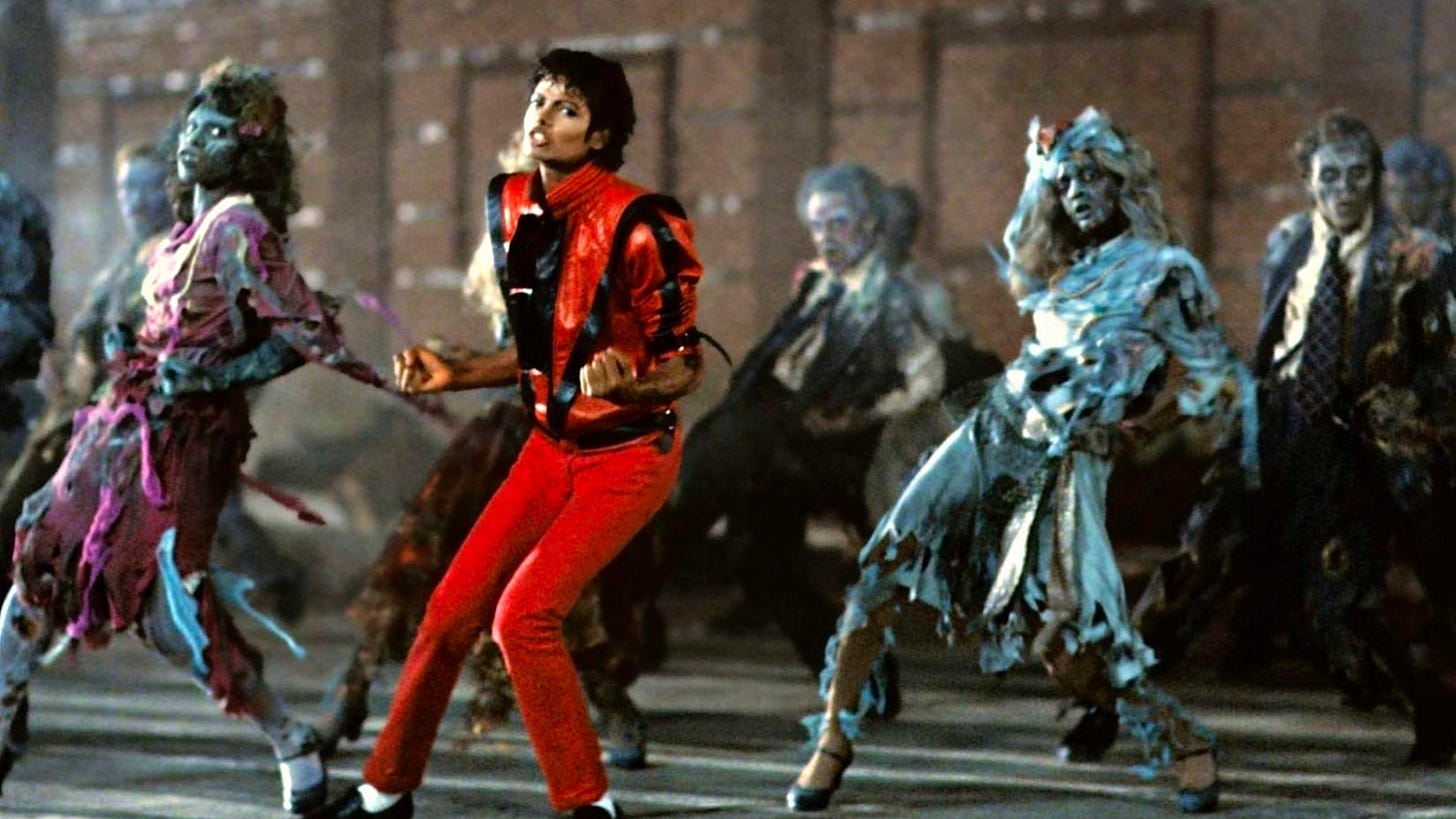The 'Thriller' Dance: 40 Years of Choreography That ‘No Mere Mortal Can Resist’
With Michael Jackson's game-changing short film, "Thriller," turning 40, its dance routine, performed by the raised undead, has proven to transcend time the most.
Michael Jackson was a master at synthesizing the best aspects of the art and art makers in his purview. This is particularly true when it comes to his dancing. He fused the feverish bombast of James Brown, the slick, subtle flair of Jackie Wilson, the acrobatics of the Nicholas Brothers, the grace of Fred Astaire, and the innovation of Don Campbell and the New York City Breakers. And yet, with all those influences, Jackson crafted an idiosyncratic style to his artistry.
Jackson showcased his prodigious pension for movement best during his short films - music videos to us mortals. His collection of visuals has given viewers a litany of iconic moves that billions have tried to copy, no different than when fans feverishly quote famous one-liners from motion pictures like “The Godfather.”
From the innocent spontaneity of movement in his first video, “Don’t Stop ‘Til You Get Enough,” to the unbridled rage in the polarizing panther dance of “Black or White,” Jackson’s dance moves elicit a visceral reaction from all who witness it. His choreographed line dances in short films like “Beat It,” “Bad,” “Smooth Criminal,” and “Remember the Time” illustrate Jackson’s uncanny flare for the intricate and the dramatic.
While debates can be made about which of Jackson’s short films is his best, what isn’t up for debate is that one dance routine stands head-and-shoulders above the rest. That routine was unleashed to the public on Dec. 2, 1983, 40 years ago.
The “Thriller” dance is the most iconic piece of choreography in modern American music history. Since its release, the routine has been copied, recreated, and lampooned to this very day. With so many incredible dance numbers in his canon, what makes the “Thriller” dance endure for so many years?
The concept was simple. “He wanted to change into a monster.” Filmmaker John Landis said that’s what Michael Jackson told him when he approached him to direct the short film. After seeing Landis’ film “An American Werewolf in London,” Jackson phoned Landis to help him make “the best” music short of all time.
Jackson’s plan to bookend his musical performance with scripted conversation at each end was carefully and masterfully crafted by himself and Landis. The transformation into a werewolf, and the undead rising from the graveyard all made for a frightening storyline that would keep the audience engaged.
The real challenge of the video, aside from dealing with a $500,000 budget without the aid of Jackson’s record label, was the choreography. Jackson recruited Michael Peters to collaborate with him on the assignment. Peters and Jackson had worked together to choreograph the dance routine for “Beat It” just months prior, so their chemistry was established. However, the idea of corpses rising from their respective graves to engage in a line dance seems strange, at best, on paper.
“It was a delicate thing to work on. My whole approach was ‘how do you make zombies and monsters dance without making it comical,’” Jackson said in a 1999 MTV interview. “We had to come up with just the right kind of movement that wouldn’t become something that you laugh at.”
Jackson described the movement he and choreographer Michael Peters created as “jazzy” and “gruesome.” The neck-and-shoulder twitch starts things out, indicating the scary, unhinged movement of the undead. The over-the-shoulder hand clap and slide into shoulder shimmy also became an image that burned into your memory.
Then there’s the arched arm swing. The curved placement of the zombies' arms as they paced back and forth seemed like a plausible pose for these creatures. But even with the dancing, it’s Jackson’s and his dancers’ commitment to remaining in character that truly brought it all together. The wide-eyed look on Jackson’s force, the recurring quivering of his lips, and facial expressions of anger and shock sold the entire performance.
Ever since the “Thriller” dance has reared its head in several places. It partially showed up in the film “Ferris Bueller’s Day Off,” it was the inspiration behind the wedding dance in “Coming To America,” also directed by Landis, and even in cartoons like “South Park.”
The real legacy of the dance is beyond the big and small screens. It’s a staple at the annual Halloween Parade in New York City. The dance has shown up at schools in the form of teacher-led flash mobs. Even inmates of a Southeast Asian penitentiary recreated the routine.
Jackson’s innovation and stature as a musical and visual futurist began before “Thriller,” but the “Thriller” short film crystallized it. He is the first, and so far only, recording artist to get inducted into the Dance Hall of Fame, and the conception, execution, and legacy of the “Thriller” dance is a big part of why.
THANK YOU FOR READING! If you enjoyed this piece, please subscribe to my page and share the piece on social media. Thanks again, and stay tuned for more!




